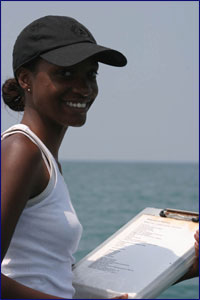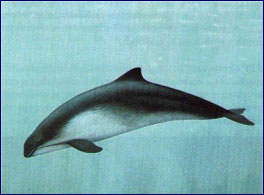|  Karitsa
Williams worked with Dr. Aleta Hohn (vitae)
and Dr. John Hare (vitae)
in determining whether an unusually high number of strandings
of harbor porpoise during the winter of 1999 was due
to an unusual juxtaposition of oceanographic features
in the western the mid-Atlantic. The goal was to investigate
whether a narrow band of cold water near shore followed
by a strong warm water front results in higher numbers
of stranded harbor porpoise than when the front is further
offshore. Karitsa
Williams worked with Dr. Aleta Hohn (vitae)
and Dr. John Hare (vitae)
in determining whether an unusually high number of strandings
of harbor porpoise during the winter of 1999 was due
to an unusual juxtaposition of oceanographic features
in the western the mid-Atlantic. The goal was to investigate
whether a narrow band of cold water near shore followed
by a strong warm water front results in higher numbers
of stranded harbor porpoise than when the front is further
offshore.
Introduction to Research
Harbor Porpoise (phocoena phocoena) are the most familiar
cetaceans distributed in the Northern Hemisphere. Harbor
porpoise are not well understood as far as biology and
ecology. They are hard to study in the wild and are
also not easy to keep alive in captivity. In 1991 Harderwijk
Marine Mammal Park was opened as a place where small
cetaceans can adapt to sea conditions before returning
to the wild. The staff kept records of techniques used
and responses of the animals to their treatment. After
improvement, porpoises were obtainable for research
on their sensory capabilities and response to types
of fishing nets.
There
are several reasons that these marine mammals are interesting
for study purposes. One reason is that they are one
of the smallest of the cetaceans and face unusual set
of problems dissimilar to most dolphins or other whales.
Another reason is that their robust body shape and thick
blubber layer allows them to adapt to cold water conditions.
More than 40% of their body is composed of blubber and
skin to keep them warm. The average size of a harbor
porpoise is 2m long and because of the small size, not
much energy can be stored in the animal. They have no
beak or no defined pigmentation pattern. The dorsal
fin is triangular and is located in the mid-body.
 Harbor
porpoise must stay close to their source of food or
starve. Along the east coast of the USA, newly weaned
calves appear stranded on beaches from Massachusetts
to North Carolina due to not maintaining a good source
of food. When calves are separated from their mother,
they are faced with the challenge of survival on their
own. Some are unable to feed on their own and therefore
become emaciated and die. This brings us to the project
in determining the relationship between sea height and
sea surface temperature on strandings of harbor porpoise. Harbor
porpoise must stay close to their source of food or
starve. Along the east coast of the USA, newly weaned
calves appear stranded on beaches from Massachusetts
to North Carolina due to not maintaining a good source
of food. When calves are separated from their mother,
they are faced with the challenge of survival on their
own. Some are unable to feed on their own and therefore
become emaciated and die. This brings us to the project
in determining the relationship between sea height and
sea surface temperature on strandings of harbor porpoise.
The
problem in this research project was to determine what
may have caused the high number of strandings during
the winter of 1999 and compare it with other years ranging
from a period of January to May from the years 1995-2001.
Sea surface temperature (SST) and sea level data was
only available for the years 1995-2001. Only one other
episode of alarming numbers of stranding of harbor porpoise
in North Carolina occurred in recent times and that
was in 1977. Also in the year 1999, where there were
a high number of stranding, a combination of oceanographic
events were seen that contributed to the high number
of strandings. In order to compare data of the 1970’s
a literature research was required that allowed a comparison
of the data collected by oceanographic sampling cruises
during the 1970’s period. The goal was to use
sea surface temperature (SST) and sea level data for
the years when it was available to ensure that those
same events did not occur in the years where high number
of strandings did not occur.
This
paper can be found in it's entirety at: http://nia.ecsu.edu/ureoms2004/teams/noaa/kwilliams_summer04.pdf |